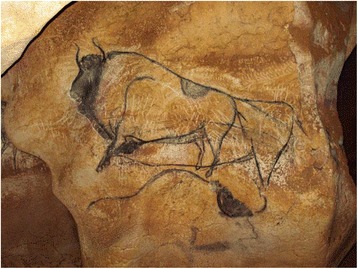Fig. 5.

Prehistoric painting of bison in the cave of Chauvet-Pont d’Arc, Ardèche, France. The paintings are the so-called “Bison of the pillar” in the “End Chamber” of the Chauvet cave. The charcoal of both paintings have been radiocarbon dated at 38.5–34.1 kya for the upper bison, and at 36.3–34.6 kya for the lower bison [30]. We consider, based on criteria stated by Spassov [19], that the “great bison” in the upper part represents B. bonasus with a highly positioned head, curved horns, a moderately large hump and a weak mane, and rather equilibrated body proportions between the front and the rear. The lower part would represent B. priscus with its large hump, its low head position, its abundant mane, and crescent-shaped horns; although somewhat faded in the image, the steep incline of the back-line and stronger hindquarters can be made out. Printed with permission of the Centre National de Préhistoire, France. (Copyright: French Ministry of Culture and Communication, archeologie.culture.fr/chauvet; Arnaud Frich, Centre National de Préhistoire/MCC).
